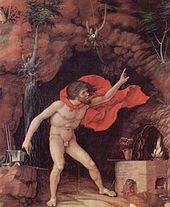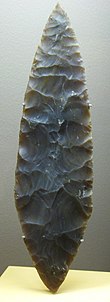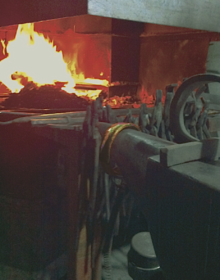anvil
An anvil (Pl. Anvils, from Old High German anabōʒ : "What on (what) to hit", "anvil") is a block of steel as a base for forming , processing mostly "warm", i.e. H. red-hot ferrous metals . An anvil is an elementary basic tool up to the present day and is an indispensable part of a forge .
The workpiece to be machined is shaped on the anvil with or without the aid of setting hammers or other auxiliary hammers by one or more forging hammers . The surface of the anvil track is hardened . Depending on the type, anvils are available between 5 kg and 550 kg.
history
The anvil is the oldest basic tool . As early as the Paleolithic Age , at least 200,000 years ago, early people used an anvil made of naturally formed stones with a flattened surface in order to use special cutting techniques to work mostly flint to make hand axes , blades or points for spears . The high level of the skilled craftsmanship between striking stone (hammer), spacers (as early auxiliary hammers) z. B. from antlers in the punching technique and anvil clearly testifies to the shield core technique of the Neanderthals . Some of the most impressive works cut in leaf form on an early anvil are the up to 40 cm large, wafer-thin (five to six millimeters in core) flint tips made in Europe around 20,000 years ago during the Solutréen culture.
At the beginning of the metal working in the copper matte time were first dignified metals such as gold and copper edited on a (rock) anvil. So far, the oldest finds of copper plates for jewelry date from the 8th millennium BC. From Anatolia .
As a result of the targeted mining of copper and its smelting at the latest in the 6th millennium BC. In today's Serbia ( Pločnik ) the well-known copper axes were cold forged on an anvil and their cutting edge was thus strengthened .
In the Bronze Age , in addition to stone anvils, the first ones made of metal ( bronze ) were also used. In addition to simple shapes, there were already those with a round horn on the side - e.g. B. for cold forging rings or bracelets.
It has been proven that the first iron anvils have been used since the Hallstatt period and gradually gained acceptance. It can be assumed that due to the early use and smelting of iron by the Hittites, iron anvils also existed before that. Since then, fire has also been indispensable for forging and continues to shape the face of a forge today.
Positioning and working method
In European antiquity and in Asia such as For example, in India or Japan , forging is still common today in a kneeling or crouching position on the floor.
In the western culture, however, most anvils today stand on a block of wood, a sand-filled box, metal legs or a similar substructure that should provide a secure stand and enable the blacksmith to work at the optimum height. Very heavy anvils rest on a heavy block of wood set into the ground, the anvil stick .
Correct positioning of the anvil ensures that the anvil introduces the same impulse into the workpiece from below with every blow of the hammer from above ; the blacksmith says "the anvil pulls".
According to the idea of the blacksmith Ponti from Milan from 1833, a metal ring with a chain is attached to each side of the horns to counter the loud din during forging. This idea was later further improved by Gaudencio Vicini with a spring that keeps the chain in tension. With this approach, the noise generated during forging can be reduced considerably.
Manufacturing
Anvils are generally either completely cast steel or cast and provided with a welded steel track and - more rarely - mostly historically, completely forged. Although an anvil made of cast iron "pulls" very well due to its high hardness and is very resistant to wear, its very bright and penetrating sound is annoying and can lead to considerable damage to the hearing , so it is urgently advisable to work with hearing protection. A suitable surface between the anvil and the base dampens the sound somewhat.
Forged anvils are nowadays considered a rarity and rarity. They sound significantly less, but “pull” just as well as their cast counterparts. Traditionally, anvils were assembled from individual pieces of soft iron (e.g. puddle iron ) and welded piece by piece in the fire . The surface for forging was either carburized or also provided with a welded, hard steel plate.
Cast anvils with a steel track are a good compromise. They do not sound as shrill as pure cast iron, but they are much easier to obtain and cheaper than forged anvils. They can be easily recognized by the cavities and pores common to all cast anvils on the underside and the parallel weld seam below the welded-on steel sheet.
Structure, variants and application

The basic shape known today was developed in the late Middle Ages . In contrast to this, a large number of differentiated anvil shapes were created regionally, each of which was adapted to the requirements of the workpieces and their size.
Different variants have developed over the centuries, e.g. E.g .: Bohemian form , North German form , South German form , Anglo-Saxon or English form . They are primarily used by blacksmiths, farriers and locksmiths (metal workers). Almost all construction methods used today have a base body with a straight or minimally curved track and, based on this, one or two pointed horns (mostly round and square horns) on which rods , rings or the like can be bent or welded .
In addition to the “typical” forms, B. for Wagner , nail smiths , goldsmiths and silversmiths u. w. Custom designs common for specialized applications.
A newly thought out form (not forged), the so-called Habermann anvil (225 kg) was created around 2005 by the "blacksmith" Alfred Habermann .
The goldsmith's anvil and silversmith's anvil is called a ratchet or chopping iron , depending on the design .
At some, e.g. B. on the South German anvil or Habermann anvil , a so-called anvil is welded to the side of the track, which tapers downward in an arc shape and is used for better straightening on the track or for tight bending or forging of curved workpieces. Additionally massive pressure plates (can edger or upsetting ) be present at the bottom of the anvil and serve for upsetting long rods. For stability, either delicate or mostly massive feet are exhibited and firmly connected, as is the case with the French anvil .
At the top of the track there is usually a square hole and one or two round holes continuous. The square hole (also known as a die holder ) is used to hold shaping and cutting tools such as auxiliary anvils , chips , croissants , goosenecks , anvil fork, etc. In the classic blacksmith language, these tools are also called heels .
The round hole (s) are used for punching with the piercing mandrel, for bending or for holding auxiliary tools. Below the track, some anvils also have a curved chest for machining larger radii.
Dengel anvil and Dengelhammer
Anvil (English Form) and Sledgehammer (English Form)
The Amboßplatz in Düsseldorf-Lörick with the monument of the same name
Musical instrument
Composers from Auber (“Le Macon”, 1825) to Britten (The burning fiery furnace, 1966) have used the anvil as a solo instrument . Well-known examples can be found in Verdi (Il trovatore (1853), Zigeunerschmiede in the 2nd act), Wagner (1853, " Das Rheingold " with the famous metamorphoses 2nd / 3rd and 3rd / 4th image, 18 anvils, on F notated in three different octaves; " Siegfried ", act 1), Walton (Belshazzar's feast). Even Albert Parlow moved him into the spotlight and gained his Anvil Polka worldwide fame. Inspired by Wagner, the Berlin military musician wrote a polka for “Solo-Anvil” (1854), his Bohemian colleague Julius Fučík wrote a concert march “Die Lustigen Dorfschmiede” (1908).
For anvil sounds, some opera orchestras use real anvils, while others use heavy steel plates over an inch thick or sections of railroad tracks.
The theory of Hipólito Rossy that the rhythm of the hammer and anvil in the hammer mills is the origin of the complex 12/8 rhythms in flamenco , especially in the seguiriya , is controversial. The harshness of the work and the noise speak against the fact that such chants could be sung during the work.
mythology
Due to the use of the anvil since the early development of mankind, it was also promised magical powers. Traditionally, a blacksmith ended the working day with five strong blows on the empty anvil. This custom was connected with the legend according to which the devil forged on an anvil tried to file his chains. With two blows he was called and banished and with three hammer blows the chains were closed and tightened again. So the five blows should serve to ward off evil forces.
Proverbs and Quotes
- "To be anvil or hammer" from the poem Another by Johann Wolfgang von Goethe from the Gesellige Lieder cycle , which says that in life you have to choose between "suffer or triumph" (quote from the poem).
- “The anvil doesn't frighten at the hammer .” - Proverb
- “The anvil is used to noise .” - Proverb
- "If you stand in front of the anvil, sparks fly into your eyes ." - proverb
- “A good anvil doesn't fear a hammer.” - Italian proverb
- “The anvil lives longer than the hammer.” - Italian proverb
- “An anvil would have a lot to do if it wanted to sigh with every blow .” - Proverb
- “If you laugh at the anvil , the hammer flies alone.” - proverb
- "Anvil today, hammer tomorrow." - proverb
- “You don't always have to forge on an anvil.” - French proverb
- “Anyone who is between anvil and hammer does not lack misery .” - proverb
- "Flexible as an anvil." - proverb
literature
- Josef Moos: Anvil forms. Hephaestus, new edition 2013, 72 pages, ISBN 978-3-931951-71-9
Web links
References and footnotes
- ↑ Academic dictionaries and encyclopedias Der Setzhammer , accessed on October 11, 2016.
- ↑ Carinthia: Journal for Fatherland Studies, Belehrung u. Entertainment . Kleinmayr, 1833 ( google.de [accessed on August 14, 2018]).
- ↑ Trad. Anvil forge Refflinghaus for anvil production , accessed on October 11, 2016.
- ^ Website from Angele (machine builder and forge supplier) on the newly designed Habermann anvil (225kg), accessed on October 11, 2016.
- ↑ Hermann Hundeshagen: The blacksmith at the anvil. A practical textbook for all blacksmiths. , Fig. Abschrot and Hörnchen see p. 37, ISBN 3-88746-430-3 , accessed on July 10, 2015.
- ↑ Hermann Hundeshagen: The blacksmith at the anvil. A practical textbook for all blacksmiths. , Fig. And explanation of “Punching with a piercer” see p. 121, ISBN 3-88746-430-3 , accessed on July 10, 2015.
- ↑ Miguel Ortiz: Seguiriya. In: FlamencoViejo.com. March 15, 2010, Retrieved October 4, 2015 (Spanish).









